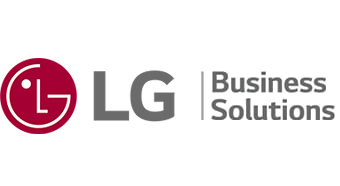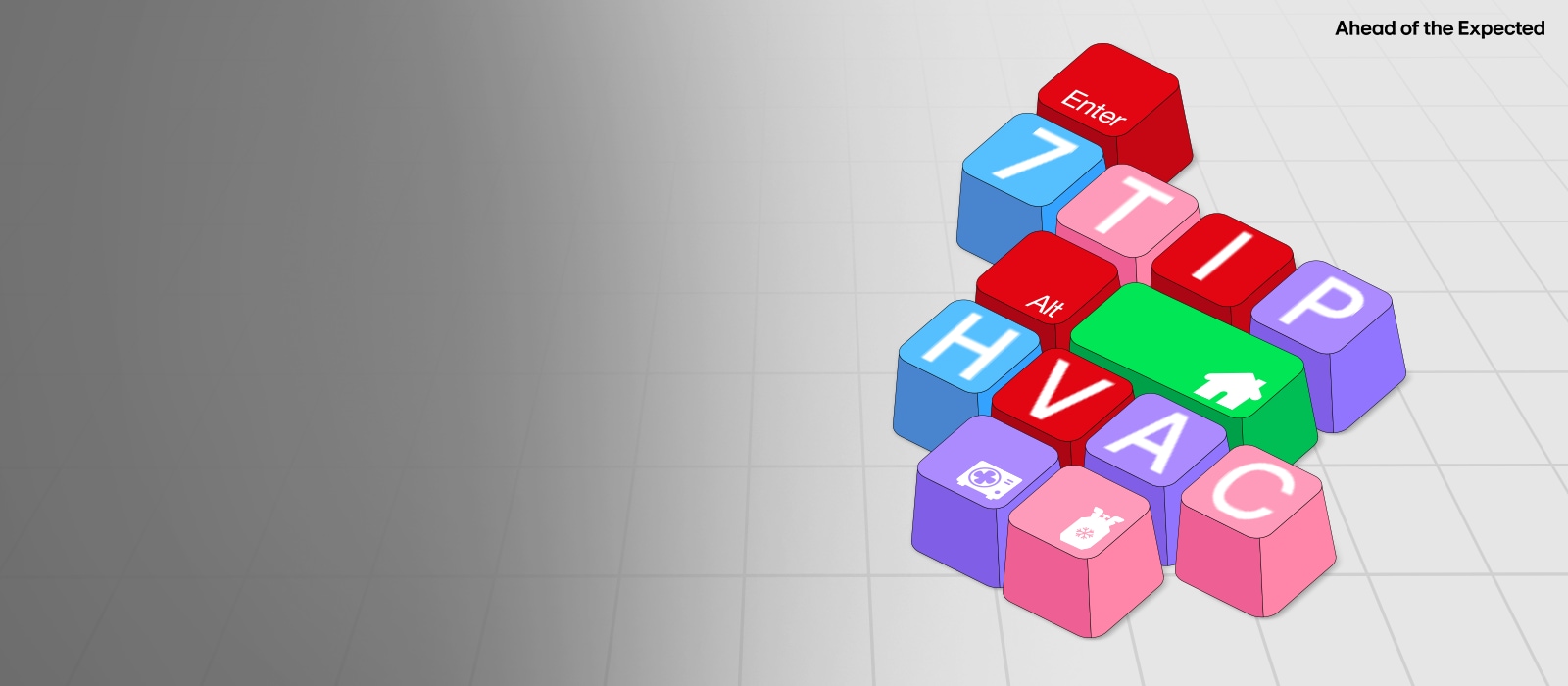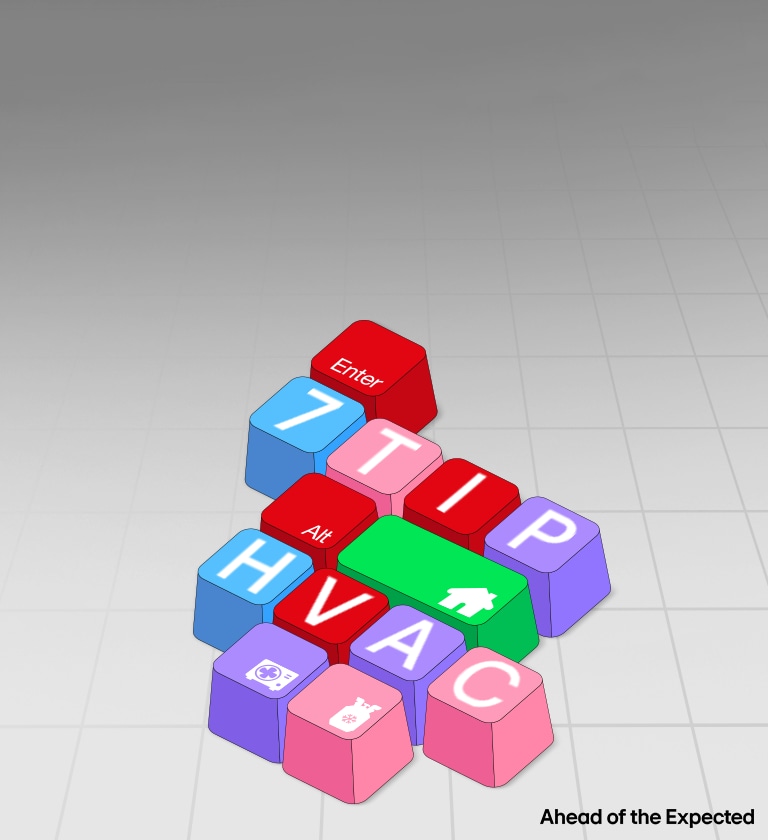-
Across the globe, more homeowners are searching for terms like “what is a heat pump” and “heat pump installation cost.” This isn’t just passing trend; it’s a sign of major shift in how heat and cool our homes. As the world moves toward electrification to meet carbon neutrality goals, heat pumps have emerged as a key technology for creating comfortable, energy-efficient living spaces.
At the same time, the HVAC industry is adapting to new standards with the adoption of lower-GWP (Global Warming Potential) refrigerants like R-32, R-454B and energy-efficient R-290 refrigerant.
This article provides seven important considerations to help you make an informed decision, aligning your investment with local policies and future sustainability requirements.
-
Heat Pump Basics: A Simple Explanation
Unlike traditional systems that burn fuel to create heat, a heat pump works by transferring heat energy from one place to another. In the winter, it extracts heat from the outside air (even when it’s cold) and moves it inside. In the summer, it reverses the process, moving heat from inside your home to the outdoors, acting just like an air conditioner. This method of heat transfer is more energy efficient than generating heat from scratch.1)
1) Actual performance may vary by climate and usage.

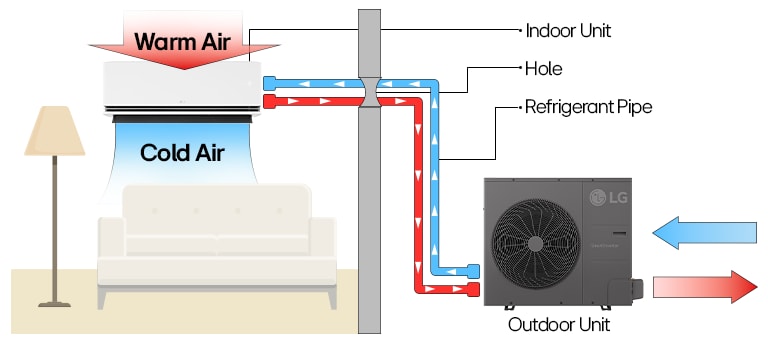
-
7 Things to Consider Before Installation
A successful installation starts with careful planning. To make an informed choice and get the most out of your new system, review these seven key areas with your HVAC professional.

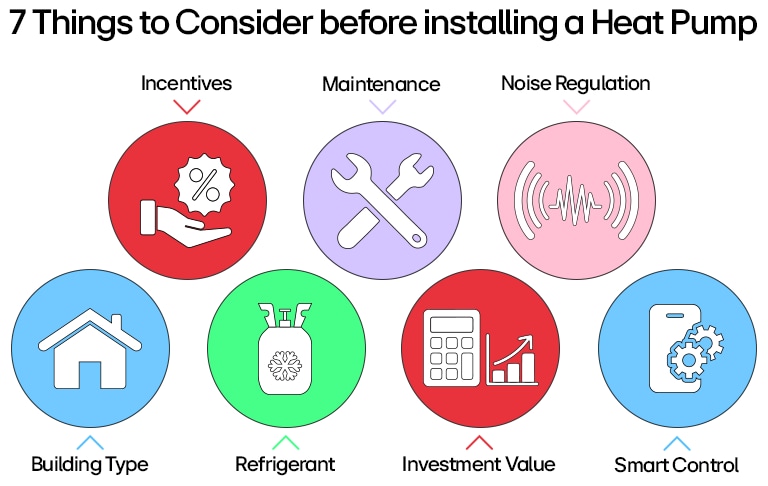
-
1. Building Type and Load Requirements
Every home is different. The right heat pump depends on your property’s size, layout, and insulation quality. A professional load calculation is crucial to determine the correct system capacity. A unit that’s too small will struggle to keep you comfortable, while an oversized unit can lead to wasted energy and reduced comfort. In addition to system capacity, it is also important to decide on the type of heat pump—such as Air to Air, Air to Water, or Water to Water—and whether the unit is a Split or Monobloc design. These choices are typically guided by the preferred heating method and the type of existing system in the building, and should be considered before selecting refrigerants.
-
2. Government Incentives and Policies
Governments worldwide are actively promoting the switch to heat pumps.
-
a. United States: Under the Inflation Reduction Act (IRA), homeowners may qualify for the Section 25C tax credit, reducing their upfront installation cost. In addition, many states operate rebate programs that can further lower expenses.
-
b. Europe: Subsidy programs continue, though some countries have recalibrated their funding levels. In many EU nations, new residential construction is no longer permitted to install fossil-fuel boilers. A wide range of rebates, grants, and even VAT reductions are offered to accelerate decarbonization, reflecting Europe’s strong policy commitment to climate action.
-
c. Middle East & North Africa (MENA): Nations like Turkey, Israel, Saudi Arabia, and Morocco are embracing electrification and renewable energy targets, opening new opportunities for heat pump adoption.
• Saudi Arabia: The nation's 'Vision 2030' plan aims to generate 50%1) of its electricity from renewables by 2030. As a result, large-scale projects like NEOM are requiring high-efficiency systems like heat pumps from the ground up.
• Turkey: The government has designated energy efficiency and renewable projects as priority investments, offering significant incentives like tax reductions. This is accelerating heat pump adoption in commercial and industrial buildings.
• Morocco: With an ambitious goal to source 52%2) of its electricity from renewables by 2030, the country is strengthening building energy efficiency codes, making heat pumps an attractive alternative to traditional systems.
※ Incentives vary by country and program availability. Always confirm eligibility with official government sources.
1) https://www.sciencedirect.com/science/article/pii/S2949821X24000668
2) https://www.trade.gov/country-commercial-guides/morocco-energy
-
3. Refrigerant Transition (R-32 / R-454B / R-290)
Environmental regulations are accelerating the shift to low-GWP refrigerants.
-
• R-32: As the current mainstream choice, this mildly flammable (A2L) refrigerant offers high efficiency with a GWP of 675, serving as a transitional solution to replace older, high-GWP options.
• R-454B: A popular R-410A replacement in North America, this mildly flammable (A2L) blend combines R-32 with an HFO for a lower GWP of 466, making it a more future-ready option than R-32.
• R-290 (Propane): A highly efficient natural refrigerant with a low-GWP of 3, R-290 is becoming the standard in Europe's strict regulatory market for applications like monobloc heat pumps, though its higher flammability (A3) requires specific safety designs.
※ Refrigerant approval and safety standards differ by market. Check compliance with local regulations before purchase.
※ GWP values are based on IPCC AR4 (Fourth Assessment Report) metrics.
-
4. Maintenance and Service Network
Even the most advanced system requires proper upkeep. Confirm that local technicians are trained for the refrigerant in use and that service and spare parts are accessible. LG HVAC maintains a global service network, while availability may vary by region.
-
5. Upfront Cost vs Long-Term Energy Savings
While the upfront installation cost can be significant, modern heat pumps are designed to reduce annual heating costs when compared with conventional fossil-fuel systems. When combined with incentives and efficiency gains, the payback period can be shortened considerably.
※ Actual savings depend on climate, home insulation, energy rates, and personal usage.

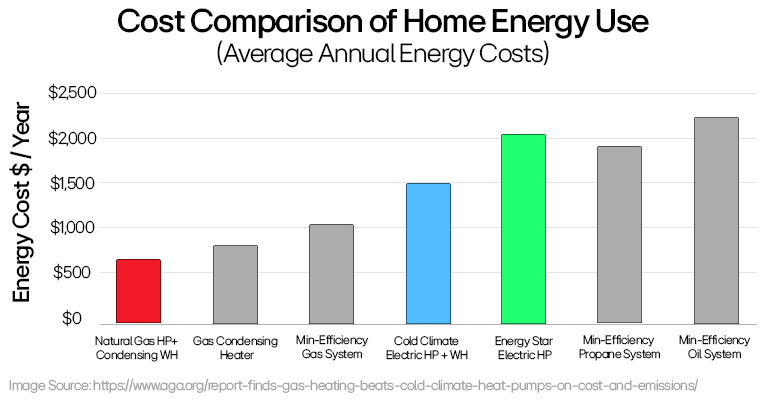
-
6. Noise and Space Requirements
A heat pump’s outdoor unit needs enough space for airflow and, just as importantly, must comply with local noise regulations to avoid disturbing your neighbors. Many countries and local authorities have strict rules about acceptable noise levels, especially at night.
For example, countries like Germany have some of the world’s strictest limits, measuring noise levels right at a neighbor’s window. In the UK, noise standards are often tied to government grants, while France measures how much a heat pump’s sound “emerges” above the existing ambient noise. In North America, the rules can change from one city or country to the next.
Because these regulations vary so widely, you must check the specific noise ordinances for your area before purchasing a unit.
-
7. Smart Controls and Connectivity
Smart controls improve both efficiency and your daily experience. With LG ThinQ™, homeowners can adjust settings remotely, monitor energy use, and receive predictive maintenance alerts that support reliable, long-term performance.
-
Find Your Perfect Match with LG HVAC Advanced Heat Pumps
Now that you know what to look for, let’s explore how LG’s innovative heat pumps meet these seven critical requirements. LG HVAC offers two distinct lineups designed to match your specific home environment and personal values.
-
LG THERMA V R290 Monobloc
For the homeowner focused on environmental responsibility and long-term energy savings, the THERMA V R290 Monobloc is the ideal solution.
It directly addresses the most demanding considerations, starting with its future-proof R-290 natural refrigerant. With a Global Warming Potential (GWP) of just 3, it complies with the low-GWP requirements set by the EU F-Gas Regulation and similar international standards. This unit translates sustainability into real savings through it’s A+++ energy rating, helping to reduce electricity bills compared to conventional boilers.


-
Furthermore, it is engineered for quiet operation to comply with even the most stringent noise ordinances in place like Germany, and has been awarded the Quiet Mark certification, demonstrating its exceptional low-noise performance. Finally, with LG ThinQ™ integration, you gain complete smart control over your heating and hot water systems, allowing you to monitor energy usage and manage your comfort from anywhere.
-
LG Multi V S R32
From larger homes with varied needs to properties with limited installation space, the Multi V S R32 offers the well-balanced combination of power and flexibility. It excels at meeting diverse building requirements by allowing a single outdoor unit to connect to multiple indoor units.
Its compact design is a direct answer to space constraints, allowing for discreet installation on balconies or in tight utility areas. Furthermore, it is equipped with a Night Time Quiet Mode, which automatically reduces operating sound during sensitive hours to help comply with strict local noise ordinances. By using the proven and efficient R-32 refrigerant, this system delivers reliable performance and excellent energy efficiency backed by LG's trusted service network.
While heat pumps in general can experience reduced performance as outdoor temperatures drop, the Multi V S R32 incorporates advanced technologies helps maintain stable heating capacity even in colder climates. This makes it a dependable option for regions with harsh winters, supporting consistent comfort throughout the year.
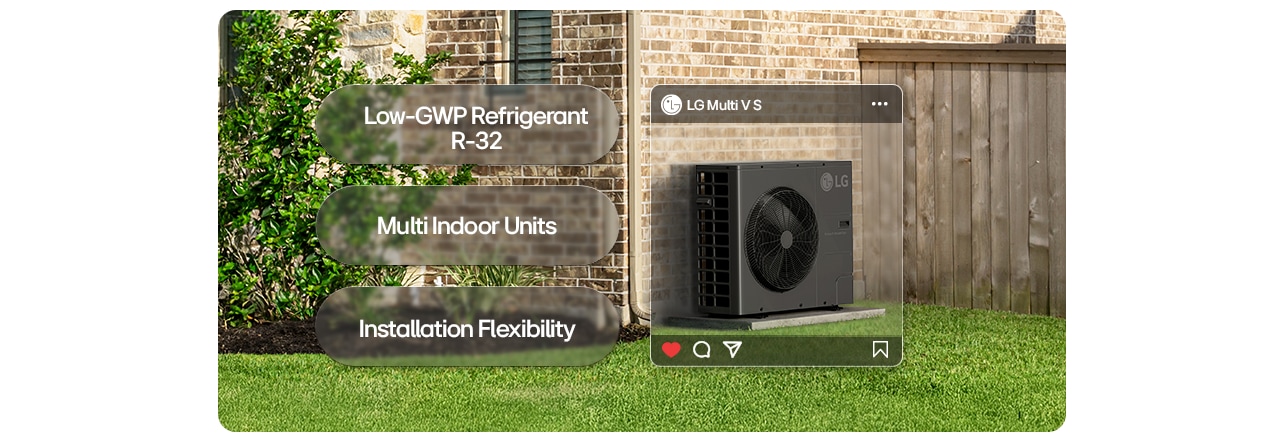
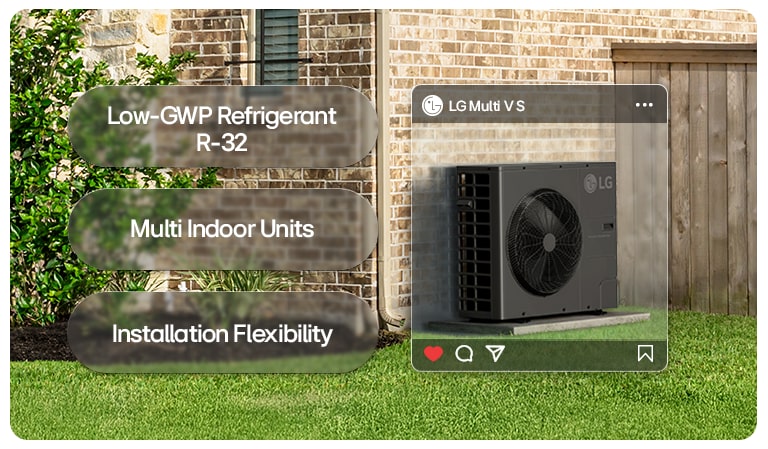
-
Summary
By carefully considering your building's needs, available incentives, refrigerant regulations, service, cost, noise, and smart features, you can make a confident decision that lowers your carbon footprint and your energy bills. With advanced solutions like LG’s Therma V R290 Monobloc, homeowners and businesses can take a meaningful step toward global decarbonization goals.
FAQs
-
Q.
Do heat pumps work in cold climates?
-
A.Yes. Thanks to significant technological advancements, new-generation systems are designed for reliable heating performance even in freezing temperatures. This is made possible by technologies such as compressor that adjust output to demand, vapor injection that stabilizes heating capacity in low outdoor temperatures, and diversified heat sources that allow systems to adapt efficiently to different climate conditions.
-
Q.
Will my electricity bill increase?
-
A.Your electricity consumption may rise, but your overall annual energy expenses are typically lower compared to heating with fossil fuels. In addition, in many regions government rebates or tax credits can further offset costs, improving the overall economics of switching to a heat pump.
-
Q.
What is the difference between R-32, R-454B and R290?
-
A.R-32 is efficient and widely available, R-454B offers a lower GWP, and R-290 is a highly sustainable option that aligns with strict EU regulations.
-
Q.
How much does heat pump installation cost?
-
A.Costs vary depending on building type, region, system complexity, and incentive programs. Industry reports indicate that installation expenses can differ significantly between markets, with some regions offering subsidies that reduce upfront costs.
-
Q.
Do heat pumps also provide cooling?
-
A.Yes. Most modern heat pumps provide heating and cooling. In summer, they reverse the heating process, moving heat out of your home just like an air conditioner. This dual functionality makes them a versatile solution for year-round comfort. For example, LG’s air source heat pumps, including the THERMA V R290 Monobloc, are engineered to deliver reliable heating in winter and efficient cooling in summer.

